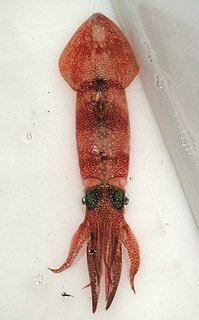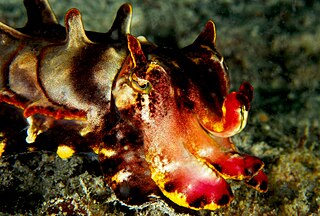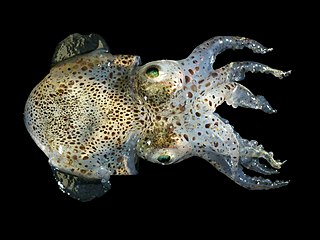
Squid are cephalopods in the superorder Decapodiformes with elongated bodies, large eyes, eight arms and two tentacles. Like all other cephalopods, squid have a distinct head, bilateral symmetry, and a mantle. They are mainly soft-bodied, like octopuses, but have a small internal skeleton in the form of a rod-like gladius or pen, made of chitin.

The Gonatidae, also known as armhook squid, are a family of moderately sized squid. The family contains about 19 species in three genera, widely distributed and plentiful in cold boreal waters of the Pacific Ocean. At least one species is known from Antarctic waters, and two from the North Atlantic. The genus Eogonatus was created for the species known as Eogonatus tinro because it did not have hooks on the tentacular club and it has 5 rows of teeth on the radula. Molecular studies in allozymes and mitochondrial DNA have indicated that this species nests within the genus Gonatus, although other authorities treat it as a synonym of Gonatopsis okutanii.

Doryteuthis plei, also known as the slender inshore squid or arrow squid, is a medium-sized squid belonging to the family Loliginidae. It occurs abundantly in coastal waters of the Atlantic Ocean, from Argentina northward to North Carolina.

Myopsida is one of the four orders of squid. It consists of two families: the monotypic Australiteuthis and the diverse and commercially important Loliginidae. Some taxonomists classify this taxon as a suborder of the order Teuthida, in which case it is known as Myopsina. This reclassification is due to Myopsina and Oegopsina not being demonstrated to form a clade.

The longfin inshore squid is a species of squid of the family Loliginidae.

Doryteuthis opalescens, the opalescent inshore squid is a small squid in the family Loliginidae. It is a myopsid squid, which is the near shore group and that means that they have corneas over their eyes. The species lives in the eastern Pacific Ocean from Mexico's Baja California peninsula to Alaska, United States, and as an inshore squid it can be found with a range of 200 miles (320 km) off the coast.

Metasepia pfefferi, also known as the flamboyant cuttlefish, is a species of cuttlefish occurring in tropical Indo-Pacific waters off northern Australia, southern New Guinea, as well as numerous islands of the Philippines, Indonesia and Malaysia. The flesh of this colorful cephalopod contains unique acids, making it unsuitable for consumption.

Sepiola atlantica, also known as the Atlantic bobtail, is a species of bobtail squid native to the northeastern Atlantic Ocean and the Mediterranean Sea.

Histioteuthis reversa, commonly known as the reverse jewel squid or the elongate jewel squid, is a species of cock-eyed squid, so called because the eyes are dissimilar. It occurs at moderate depths in the Atlantic Ocean and Mediterranean Sea and is also known from the Indian Ocean.
Sepia zanzibarica, or the Zanzibar cuttlefish, is a species of cuttlefish native to the Indian Ocean.

Uroteuthis is a genus of 14 species of common inshore squids of the Indo-West Pacific and is further subdivided into 3 subgenera. The members of the genus Uroteuthis are the only squids of the family Loliginidae that possess photophores and all species in the genus have a pair of photophore organs on the ventral surface of their ink sac either side of their intestine.
Afrololigo mercatoris, commonly known as the Guinean thumbstall squid, is a small species of squid in the family Loliginidae from the eastern central Atlantic Ocean. It is the only species in the monotypic genus Afrololigo.
Loliolus is a genus of squid from the family Loliginidae from the Indo-Pacific region. The genus is divided into two subgenera Loliolus and Nipponololigo. They are small squids of less than 150mm in mantle length which have an expanded tentacular club. This club has 4 series of suckers. The sucker ringss have plate-like teeth which are square in shape all around them. The males' hectocotylus has a ventral crest which is created by the fusion of the protective membrane with the ventral series of papillae and this crest completely obscures the conical shape of the papillae. The mantle is rounded posteriorly and lacks the posterior tail-like lobe while the fins are positioned on the rear of the mantle and extend to the posterior tip of the mantle. Their eggs are small and the males' spermatophore has a short cement body. They do not possess photophores. The two subgenera are distinguished by the hectocotylus which in Loliolus encompasses the entire arm and there are no unmodified suckers while in Nipponololigo the arm is only partly hectocotylsed and has normal suckers at its base.
Lolliguncula is a genus of squid from the family Loliginidae from the eastern Pacific and western Atlantic, known as brief squid. The genus is divided into two subgenera Lolliguncula and Loliolopsis. They are rather small squids with a maximum mantle length of 120mm, that inhabit shallow warm seas, although some species have been recorded in areas of low salinity. They are typified by having a short mantle, which is round at the posterior; and fins that are broader than long, but which have no posterior lobes. The males produce spermatophores with a long cement body and they lack a ventral crest on their hectocotylus. Their suckers have square teeth which ring the entire margin or are placed distally. The males do not have enlarged suckers on the left ventral arm. The tentacular club is expanded and contains suckers in four series. The two subgenera differ in the morphology of the hectocotylus.

Slosarczykovia is a monotypic genus of squid, its sole representative being Slosarczykovia circumantarctica. Slosarczykovia is placed in the family Brachioteuthidae.
Neoteuthis is a monotypic genus of squid, the sole member is Neoteuthis thielei, from the family Neoteuthidae. This species has long tentacular clubs measuring 60% of the mantle length and fins which are 70% of its mantle length. It has a proximal locking-apparatus for the club which is restricted to manus, which in turn has proximal suckers which are circular. It has been recorded from the South Atlantic Ocean, North Atlantic Ocean, near the Canary Islands and North Pacific Ocean, north of Hawaii. The paralarvae and juveniles are found in the epipelagic to mesopelagic zones while adults occur in the mesopelagic to bathypelagic zones.
Eucleoteuthis is a monotypic genus of squid from the family Ommastrephidae, the only species is Eucleoteuthis luminosa, the striped flying squid or luminous flying squid.
Ornithoteuthis volatilis, the shiny bird squid, is a squid from the subfamily Ommastrephinae, the flying squids, of the family Ommastrephidae part of the pelagic squid order Oegopsida. It is a tropical and sub-tropical species which is widely distributed in the Indo-Pacific oceans. It is slightly larger than the closely related species Ornithoteuthis antillarum of the Atlantic Ocean.
The Angolan flying squid is a species of squid from the subfamily Todarodinae, part of the familyOmmastrephidae. Due to taxonomic confusion with the Antarctic flying squid the exact limits of its distribution are uncertain but it is thought to be restricted to waters off Southern Africa.

Doryteuthis gahi, also known as the Patagonian longfin squid and Patagonian squid, is a small-sized squid belonging to the family Loliginidae. It occurs in coastal waters in the southeastern Pacific Ocean and the southwestern Atlantic Ocean where it is caught and eaten for food.












